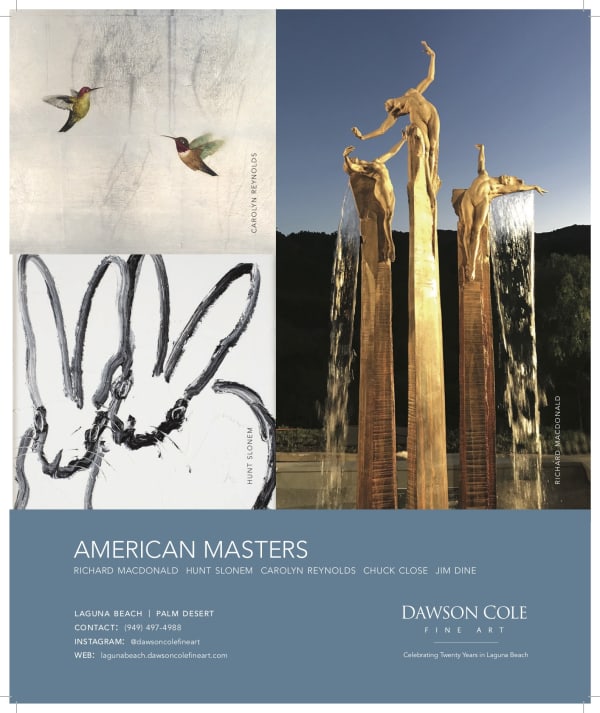Jim Dine American, b. 1935
Jim Dine is a major post-war artist whose work ranges from vibrant, large-scale paintings to exquisitely-rendered, romantic drawings and bronze sculpture. Dine's debut on the New York art scene came via several "happenings" performances along with artists Claes Oldenburg and Robert Whitman in the early 1960s. Since then Dine's name has been inextricably linked with the Pop Art movement, but his diverse body of work defies such easy categorization. Over the past five decades, Dine has created a wide breadth of work: drawings, works on paper, paintings, assemblages, and sculpture. His subjects have included plants, animals, figures, puppets, and self-portraits, and his iconic depictions of hearts, tools, and robes have become the hallmark of his oeuvre. Dine studied at the University of Cincinnati and the Boston Museum School, and received his B.F.A. from Ohio University, Athens, where he was also enrolled in the graduate program. He moved to New York City in 1958, where he had his first group (1959) and solo (1960) exhibitions. Since his first solo exhibition in 1960, Dine’s paintings, sculptures, photography, and prints have been the subject of nearly 300 solo exhibitions worldwide.
JIM DINE: A LIFE IN PRINT from NGV on Vimeo.
Jim Dine is an American painter, graphic artist, sculptor, and poet who emerged during the Pop Art period as an innovative creator of works that combine the painted canvas with ordinary objects of daily life. Dine studied at the University of Cincinnati and the Boston Museum School, and received his B.F.A. from Ohio University, Athens, where he was also enrolled in the graduate program. Dine moved to New York in 1959 where he became a key figure in the Happenings movement. His talent was quickly recognized, leading to his first solo exhibition was held at the Reuben Gallery, New York in 1960.
Although Dine’s prominence in the New York art scene led him to befriend Pop Art figures including Claes Oldenburg and Roy Lichtenstein, his works strayed from the traditional subjects typically associated with that movement. Instead, the everyday objects Dine incorporates into his art are often personal possessions, lending a powerful sense of autobiography to his works. His subjects have included plants, animals, figures, puppets, and self-portraits, and his iconic depictions of hearts, tools, and robes have become the hallmark of his oeuvre.
Over the past five decades, Dine has created a wide breadth of work: drawings, works on paper, paintings, assemblages, and sculpture. Dine has been given solo exhibitions at museums throughout Europe and the United States, including a major retrospective at the Whitney Museum of American Art in 1970, the Solomon R. Guggenheim Museum in 1999, and the National Gallery of Art in Washington, D.C. in 2004. In 1971 Jim Dine produced the first paintings in which a large heart appears on its own, a device to which he has since returned both on canvas and at regular intervals in his graphic work. It has served him for almost as many reasons as he needs for making art: as a formal device, as a stand-in for the body, as a sexual image, and an emblem of romance, and as a sign of erotic love and desire...The advantages, particularly with such a simple shape, were many: it was impossible to forget, graphically arresting, sufficiently neutral to support a variety of associations, and so flexible as a container for an infinite range of marks, colors and other images that it was unlikely ever to outlive its usefulness. It has certainly continued pumping life into Dine's paintings, drawings, prints and sculptures more than thirty years on.
-

Splash of Summer
A Group Exhibition 31 Jul - 8 Sep 2023 Laguna Beach, Palm DesertStep into a vibrant world of art that captures the essence of the season at the mesmerizing exhibition, 'Splash of Summer.' This exhilarating showcase is a celebration of all things...Read more -

Red Redefined
The Evocative Power of the Color Red 1 - 28 Feb 2022 Laguna Beach, Palm DesertDawson Cole Fine Art presents an exhibition of works by gallery artists – “Red Redefined.” The group show consists of fourteen works and includes paintings, bronze sculpture, prints, and hand-blown glass by gallery artists.Read more -

LOVE + MODERN BEAUTY
30 Jan - 15 Feb 2021 Laguna BeachDawson Cole Fine Art is pleased to present 'LOVE + MODERN BEAUTY' from January 30- February 15, 2021. There’s something to be said about the holiday’s celebration of love, and...Read more -

Jim Dine: Printmaker
7 - 31 Mar 2019 Laguna Beach, Palm DesertUnlike many artists who produce editions, printmaking is a deliberate media choice for Jim Dine, enabling him tremendous freedom to explore, experiment and push the limits of the conventional wisdom...Read more
-

Curated Coastal
Issue 4 March 22, 2022 Read more -

El Paseo
Palm Desert 2022 January 1, 2022 Read more -

Dawson Cole Fine Art Highlighted: The Best of California 2021
224 Reasons to Love the Golden State: Dawson Cole Fine Art, Laguna Beach May 19, 2021 Read more -

American Masters
May 5, 2020 Read more -

California Homes Magazine August 2019
Shopping for Art in Laguna Beach August 1, 2019Celebrating its 22nd year, Dawson Cole Fine Art was recently featured in California Homes Magazine's August 2019 issue as one of the 'go to' places...Read more














